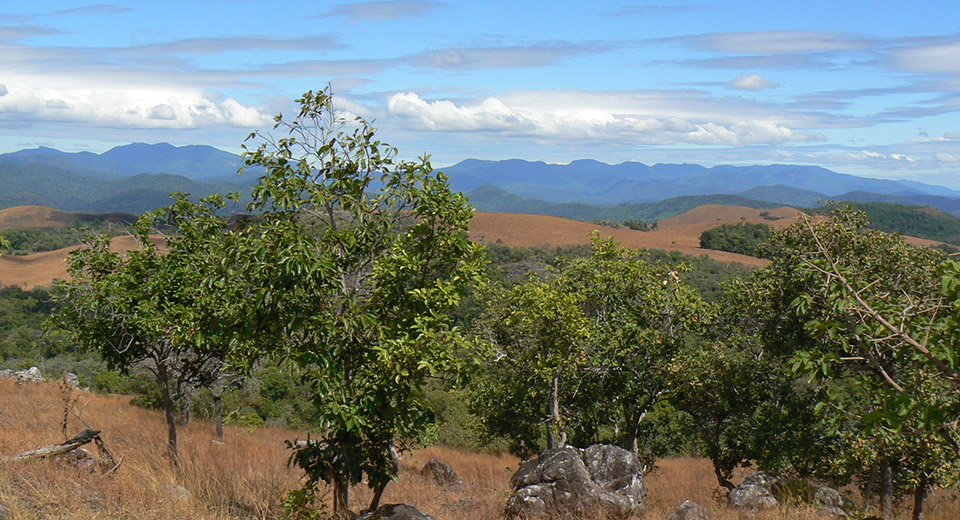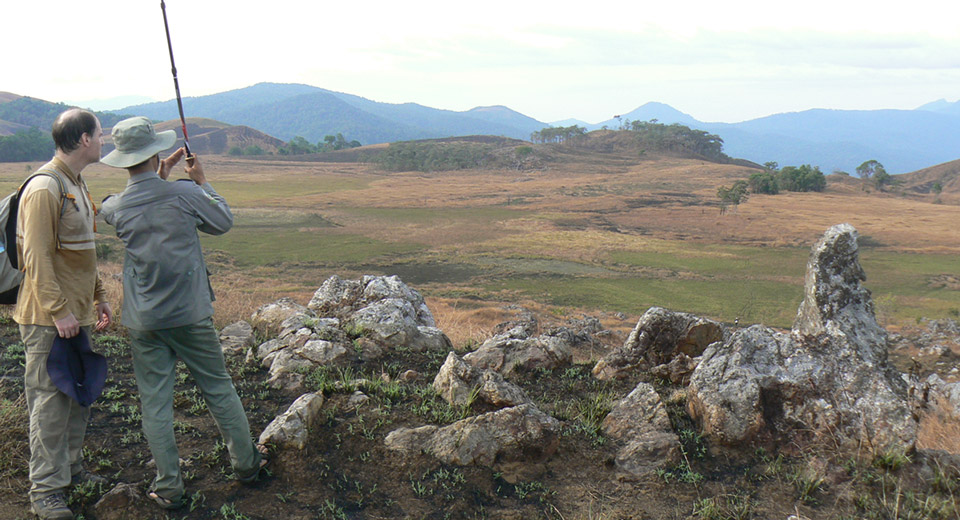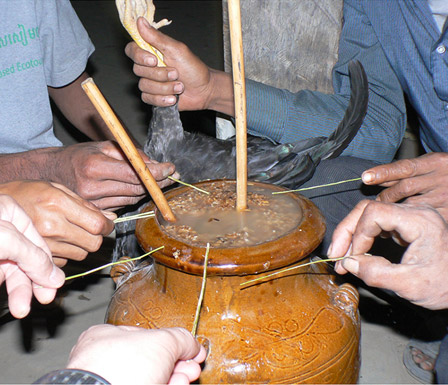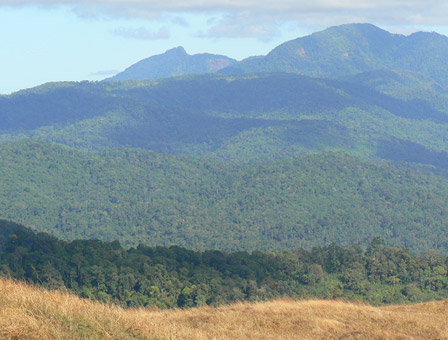સાઇટ વર્ણન
પર્વતીય વિરાચે રાષ્ટ્રીય ઉદ્યાન (Vnp) કંબોડિયાનો સૌથી મોટો સુરક્ષિત વિસ્તાર છે. દેશના આત્યંતિક ઉત્તર -પૂર્વમાં સ્ટંગ ટ્રેંગ અને રતનકીરી પ્રાંતોમાં સ્થિત છે, તે દુર્લભ વનસ્પતિ અને પ્રાણીસૃષ્ટિનું ઘર છે. પરંપરાગત રીતે પાર્કના બફર ઝોન વસે છે હાઇલેન્ડર જાતિઓના અસંખ્ય જૂથો, જેમ કે બ્રેઓ, નિર્માણ, અને કેવેટ. તેમને કાયદેસર રીતે માછલીની મંજૂરી છે, જંગલી પિગ જેવી બિન-જોખમી જાતિઓનો શિકાર કરો, અને ઉદ્યાનની સીમામાં બિન-ટીએમ્બર વન ઉત્પાદનો એકત્રિત કરો. તેઓ સૌથી મોટા પર્વતોને ધ્યાનમાં લે છે "સ્પિરિટ પર્વતો". આ અને અન્ય પવિત્ર કુદરતી સ્થળો સમૃદ્ધ એનિસ્ટિક લોકવાયકાથી ઘેરાયેલા છે જેની વિગતો ગામો અને જાતિઓ વચ્ચે બદલાય છે.
ઇકોલોજી અને જૈવવિવિધતા
આ પાર્કમાં અપલેન્ડ સવાન્નાનો સમાવેશ થાય છે, અર્ધ-સદાબહાર નીચું, મોન્ટેન જંગલો, વાંસની ઝાડ અને મિશ્ર પાનખર વન. પાર્કનો મોટાભાગનો ભાગ ઉપર આવેલો છે 400 સ્પિરિટ માઉન્ટેન હેલિંગ-હલાંગની સૌથી વધુ ટોચ સાથે મીટર 1,475 મીટર. જંગલી પ્રાણીઓમાં એશિયન હાથીઓનો સમાવેશ થાય છે, વાદળછાંટ (નિયોફેલિસ નિહારિકા), આજ (ગ RA રસ), અને ધમકીભર્યા લાલ-શેન્ક્ડ ડબ લંગુર જેવા પ્રાઈમેટ્સની અસંખ્ય પ્રજાતિઓ (પિગાથ્રિક્સ નેમેયસ). સ્થાનિક અફવાઓ લુપ્ત થઈ ગયેલી પ્રજાતિઓની હાજરી પણ સૂચવે છે.
ધમકીઓ
સ્થાનિક ઇકોસિસ્ટમ્સ માટેના મુખ્ય જોખમો ઝડપી જંગલો અને જમીન છે- આર્થિક જમીનની છૂટ વેચવાની સરકારની નીતિને કારણે ફાળવણી, રબર અને કાજુના વાવેતર તરીકે વપરાય છે. આવી છૂટછાટોનું વિસ્તરણ ઝડપી છે અને તે કંબોડિયાના જંગલી સ્થાનો અને એનિમેસ્ટ સંસ્કૃતિઓના બાકીના લોકો દ્વારા આક્રમક રીતે આંસુ. તેવી જ રીતે, પ્રદેશમાં હાઇડ્રોપાવર વિકાસ, શહેરી પ્રદેશો માટે નિર્ધારિત નદીઓને દૂષિત પાણીના સ્થિર પૂલમાં ઘટાડે છે.
આને લગતા વલણ છે કે આ પ્રદેશના યુવા રહેવાસીઓ પ્રાચીન પરંપરાઓને ભૂલી જાય છે, આધુનિક જીવન શૈલીઓ અપનાવવાની લાલચ. હકીકતમાં, કેટલાક તેમના એનિમેસ્ટ હેરિટેજને એકસાથે ટાળશે તેવું લાગે છે.
સંરક્ષકો
પર્વતોને શક્તિશાળી દેવતાઓનો ઘર માનવામાં આવે છે જે દુષ્કાળ સમયે વરસાદ લાવી શકે છે, બીમાર કુટુંબના સભ્યોને મટાડવું, અને વસંત પણ જેલમાંથી લોકોને કેદ કરે છે. બ્રેઓ લોકો, બફર ઝોનમાં રહેવાસી, વિરાશેના સ્પિરિટ પર્વતોથી ડરતા હોય છે. તેઓ ખાસ કરીને હેલિંગ-હલાંગ વિશે નર્વસ છે, જે કેટલીકવાર તરફેણના બદલામાં માનવ બલિદાનની માંગ કરે છે. હેલિંગ-હલાંગ પર કોઈ શિકાર અથવા લ ging ગિંગની મંજૂરી નથી. અમુક સાઇટ્સના મુલાકાતીઓએ નિવાસી આત્માઓને પ્રાર્થના કરવી આવશ્યક છે. જેઓ આ વાંસને એકત્રિત કરવા માંગે છે તેઓએ સ્થાનિક "જાદુઈ માણસ" સાથે સલાહ લેવી જ જોઇએ કે જે વાંસને કેટલું લઈ શકાય તે શોધવા માટે આત્માઓ સાથે સંપર્કમાં આવશે, અને જે બલિદાનની જરૂર પડશે. વાર્તા એવી છે કે એક યુવાન બ્રેઓ માણસે એકવાર “જાદુઈ માણસ” ની સલાહ લીધા વિના હેલિંગ-હલાંગ વાંસને કાપી નાખ્યો. કાપતી વખતે, વાંસનો એક તીવ્ર ટુકડો તેના પગને વીંધે છે. ઈજાએ તેને લગભગ માર્યો ગયો. આ એનિમેસ્ટ રીતો, વિવિધ સાઇટ્સ માટે પણ સચિત્ર, પરોક્ષ રીતે વન્યપ્રાણી સંરક્ષણમાં પરિણમે છે.
શું યોકે મને જાણ કરી કે ટેમ્પુઆન ગ્રામજનો કે જેમણે ઝાડને ફેલાવી દીધા હતા તે વિયેતનામીસ ખરીદદારોની વિનંતી પર આવું કર્યું - આ ચોક્કસ બાયોરેજિયનમાં રહેતા નથી અથવા તેના પર ગંભીર નકારાત્મક અસર કરે છે તે સમજતા નથી.“તમે ત્યાં કટ વૃક્ષ જુઓ છો?? તે લઘુમતી લોકો દ્વારા કરવામાં આવ્યું હતું. આનાથી પવિત્ર તળાવ પર આત્માઓ ગુસ્સે થઈ, ત્યારબાદ લઘુમતી ગામના ઘણા લોકોની હત્યા કરી હતી જ્યાં લોગર્સ આવ્યા હતા, અને ગામના બધા લોકોને આ વિસ્તારની બહાર જવું પડ્યું. હવે પણ, પાર્કમાં લઘુમતી ભાષાઓ બોલી શકાતી નથી, અથવા જે લોકો તે બોલે છે તે બીમાર થઈ જશે અને ખૂબ જ ઝડપથી મરી જશે. "
- "કંબોડિયામાં એનિમિઝમથી: ટ્રમ્પેટરમાં બાયોરેજિનોલિઝમ ”, વોલ્યુમ 27 કોઈ 1 (2011) 8-22 ગ્રેગરી મ C ક ann ન દ્વારા.
દ્રષ્ટિ
પાર્ક્સ સાંસ્કૃતિક અને કુદરતી વારસોને બચાવવા માટે હજી સમય છે. બફર ઝોનમાં સમુદાયોના ગઠબંધનની સ્થાપનાથી આ વિસ્તારને ફાયદો થશે જે ટૂર ગાઇડ્સ તરીકે પૈસા કમાય છે, યજમાન, ખેડૂત, માછીમારો, અને અન્ય સમકાલીન વ્યવસાયો, તેમના એનિમેસ્ટ હેરિટેજનો ત્યાગ કર્યા વિના. વડીલોથી યુવા પે generation ીમાં આંતરસંસ્કૃતિક ટ્રાન્સમિશનને પ્રોત્સાહનની જરૂર છે, આદિજાતિઓમાં ટ્રાન્સમિશન દ્વારા પ્રબલિત. યુવાનો સ્કૂટર્સ ચલાવી શકે છે, સેલ ફોન પર વાત કરો, શહેરમાં કામ, અને તેમના સમૃદ્ધ એનિસ્ટ હેરિટેજ પર પણ ગર્વ અનુભવો.
ક્રિયા
તળિયાના પ્રયત્નો ચાલી રહ્યા છે. હ ing લિંગ-હલાંગ પર ક camera મેરા-ફસાયેલા પ્રોજેક્ટનો હેતુ ઉદ્યાનમાં ગંભીર રીતે જોખમમાં મૂકાયેલી જાતિઓની હાજરીને ચકાસવા અને સ્વદેશી લોકોનો સમાવેશ કરવાનો છે, ઉદ્યાન, એનજીઓ કામદારો, અને પવિત્ર પર્વતોને સુરક્ષિત રાખવા માટે સંકલિત પ્રયત્નોમાં ટૂર ઓપરેટરો. વાર્તા કહેવાના સત્રો અને પવિત્ર પર્વતોથી ટ્રેકિંગ્સ પ્રવાસીઓ તેમજ યુવાન સ્થાનિક લોકોને શિક્ષિત કરે છે, તેમને બાકીના એનિમેસ્ટ દંતકથાઓ શીખવા માટે સક્ષમ કરવું. એથનોગ્રાફિક ઇન્ટરવ્યુ પરિસ્થિતિમાં આંતરદૃષ્ટિ પેદા કરે છે, આ જમીનોના મૂલ્ય વિશે વૈશ્વિક જાગૃતિ લાવવામાં પણ મદદ કરે છે.
નીતિ અને કાયદો
સ્વદેશી લોકોને કાયદેસર રીતે માછલીની મંજૂરી છે, બિન-ટેમ્બર વન ઉત્પાદનો એકત્રિત કરો, અને જંગલી ડુક્કર અને જંગલ મરઘી જેવી બિન-જોખમી જાતિઓનો શિકાર કરો. તેઓએ પરંપરાગત રીતે સુરક્ષિત પ્રજાતિઓ આવી પેંગોલિનનો શિકાર કર્યો ન હતો પરંતુ વિયેટનામમાં ઉચ્ચ પગાર આપનારા બજારો સાથે, પૈસા કમાવવાની લાલચ હવે કેટલાક માટે ખૂબ મોટી છે.
પાર્ક વચ્ચે સારી રીતે સુરક્ષિત છે 2004 અને 2008, જ્યારે વર્લ્ડ બેંકના પ્રાયોજકતાએ અમલના રક્ષણાત્મક કાયદાને સક્ષમ કર્યા. જ્યારે કંબોડિયન સરકારે મૂલ્યવાન ખનિજો માટે પાર્કનું અન્વેષણ કરવા ભથ્થું જાહેર કર્યું ત્યારે પ્રાયોજકતા રદ કરવામાં આવી હતી. તે વ્યાપક લ ging ગિંગમાં પરિણમે છે, શિકાર, અને અતિક્રમણ. પાર્કનો આશરે એક તૃતીયાંશ હવે વ્યવસાયિક મિલકત છે. એક અસ્થાયી મોરટોરિયમ હાલમાં સ્થાને છે.
સાથે મળીને કામ
અત્યાર સુધી, આ ક્ષેત્રમાં વિવિધ પક્ષો વચ્ચે સહયોગ નબળો છે. ગામો વચ્ચે પણ, જમીન વેચાય છે અથવા બહારના લોકોને ગેરકાયદેસર રીતે હસ્તાક્ષર થતાં સામાજિક ફેબ્રિક ઝઘડવાનું શરૂ થયું છે. કંબોડિયન સરકાર વિશ્વના સૌથી ભ્રષ્ટ લોકોમાં સૂચિબદ્ધ છે. તેમ છતાં એનજીઓ આવાસ આઈડીની સંડોવણી છે, અને ઘણી યુનિવર્સિટીઓ આ ક્ષેત્રમાં કામ કરે છે. આ આશા આપે છે, પરંતુ ઘણું કામ કરવાનું બાકી છે.
સંરક્ષણ સાધનો
આ ક્ષેત્રમાં પ્રકૃતિને બચાવવા માટે જીવનની પરંપરાગત પ્રકૃતિ મૈત્રીપૂર્ણ રીતોને મજબૂત બનાવવાનો અર્થ છે. "એનિમેસ્ટિક ઇકોટ્યુરિઝમ" એ આ પ્રયત્નોને સમાવિષ્ટ કેન્દ્રિય ખ્યાલ છે, વાર્તા કહેવાના સત્રો અને ટ્રેકિંગ પ્રવાસ સહિત. વધુમાં, પરંપરાઓનું સંશોધન અને દસ્તાવેજીકરણ અને ઉદ્યાનમાં મહત્વપૂર્ણ કુદરતી સુવિધાઓ નીતિ ઉત્પાદકો જેવા બહારના લોકોને તેના બાકીના મૂલ્ય વિશે જાગૃત થવા માટે સક્ષમ બનાવે છે. સાંસ્કૃતિક દસ્તાવેજીકરણ હાલમાં એથનોગ્રાફિક ઇન્ટરવ્યુ સાથે કરવામાં આવે છે. સેક્રેડ પર્વતો પર ગતિ-ટ્રિગર્ડ કેમેરા-ફસાઇને વિસ્તારના કુદરતી મૂલ્યો વિશેના દાવાઓને ચકાસવા માટે ટૂંક સમયમાં પ્રારંભ કરવામાં આવશે, જેમ કે દુર્લભ અને સ્થાનિક રીતે લુપ્ત પ્રજાતિઓનું સતત અસ્તિત્વ.
પરિણામો
આ ક્ષેત્ર વિશે લખાયેલા અસંખ્ય શૈક્ષણિક પ્રકાશનોની બાજુમાં, પ્રયત્નોએ વી.એન.પી. બફર ઝોનમાં ઘણા ગામોની મુલાકાત લીધી હોય તેવા બાતમીદારો અને અનુવાદકોનું વિસ્તૃત અને વિશ્વસનીય નેટવર્ક સ્થાપિત કર્યું છે., અને હવે પરંપરાઓ પર તદ્દન જાણકાર છે. તેઓ પ્રદેશના અધિકારો માટે આગળના મહત્વપૂર્ણ હિમાયતીઓ હોઈ શકે છે, જ્યારે કી હિસ્સેદારોને ખાતરી કરવાની વાત આવે છે.
નજીકના ભવિષ્યમાં, આવાસ આઈડી આ ક્ષેત્રમાં આત્માઓની દંતકથાઓ અને દંતકથાઓ ધરાવતું પુસ્તક છાપશે. આ પ્રદેશના ગામોમાં વિખેરી નાખવામાં આવશે. છેલ્લે, લાંબા પ્રયત્નોના પરિણામે એક સ્વયંસેવક કેમેરા ટ્રેપ પ્રોજેક્ટ પરો .વાનો છે.
“બુનોંગ લોકો જંગલને ચાહે છે અને તેનું રક્ષણ કરવા માંગે છે,”શરૂ કરવા માટે. “અમારો પરંપરાગત ધર્મ જંગલ માટે સારો છે. જો આપણે જંગલનો આદર કરીએ તો જંગલ આપણને જરૂરી બધું આપી શકે છે. દરેક વસ્તુ. પરંતુ જો આપણે જંગલનો આદર ન કરીએ, પછી જંગલ મરી જશે, અને આપણે બધા બીમાર થઈશું. "
- એક પર્વત ભાવના દ્વારા દૂર બોલાવ્યો (2013, ડો. સિસિરો, પી. 87) ગ્રેગરી મ C ક ann ન દ્વારા.
- ઉન્મત્ત, ઇયાન જી. “ઓળખ અને જગ્યા: ઉત્તર પૂર્વીય કંબોડિયામાં બ્રાવ વચ્ચે ધાર્મિક પરિવર્તનની ભૂગોળ. " માનવશાસ્ત્ર 104 2009: 457-468" 2009.
- “માર્જિનને નિયંત્રિત કરવું: ઉત્તર પૂર્વીય કંબોડિયામાં પ્રકૃતિ સંરક્ષણ અને રાજ્ય શક્તિ. " વિકાસ અને આચાર: કંબોડિયા, વિયેટનામ અને લાઓસ. ફ્રેડરિક (ઇડી.) સફેદ લોટસ પ્રેસ: બેંગકોક. 2009.
- કોતરણી, અવસ્થાનું. રતણકીરી: કિંમતી પત્થરોનો પર્વત. 2006
- "જ્યારે માર્જિન એકના પગલાને ઇચ્છાના to બ્જેક્ટ તરફ ફેરવે છે." માર્જિન પર જીવવા. ખ્મેર અભ્યાસ કેન્દ્ર: ફનમ પેન. 2009
- વિકાસ અને આચાર. સફેદ લોટસ પ્રેસ: બેંગકોક. 2009.
- ગુંડો, ખરબચડું. ઇકોટ્યુરિઝમ અને સસ્ટેનેબલ ટૂરિઝમમાં "ઉદ્યાનો અને પર્યટન": નવા દ્રષ્ટિકોણ અને અભ્યાસ. સફરજન: ન્યુ યોર્ક. 2011.
- ડેવિસ, વેડ. સંપૂર્ણ. જોખમમાં મુકેલી સંસ્કૃતિઓના સપના. ટેડ. મંટરરી, 2007. રજૂઆત.
- સોટોથી, હર્નાન્ડો. મૂડીનું રહસ્ય. કાળો રંગ: લન્ડન. 2000
- ધણ, પીટર જે. "દુર્ઘટના તરીકે વિકાસ: કંબોડિયામાં એશિયન ડેવલપમેન્ટ બેંક અને સ્વદેશી લોકો ”માર્જિન પર રહે છે. ખ્મેર અભ્યાસ કેન્દ્ર: ફનમ પેન. 2009.
- ઇરાદાપૂર્વક, જેરેમી. "વિકાસ - જેમના નામે?”માર્જિન પર જીવવું. ખ્મેર અભ્યાસ કેન્દ્ર: ફનમ પેન. 2009
- મિશિકેન, ગ્રેગ. પર્વત ભાવના દ્વારા દૂર કહેવામાં આવે છે. ડો. સિસિરો: ન્યુ યોર્ક. 2013.
- “બાયોરેજિયન્સ અને સ્પિરિટ પ્લેસ: જીમ ડોજના લાંબા સમયથી ખોવાયેલા સૂચન હાથ ધરવા. " ધ્રુવીય 27.3 (2011): 10-26.
- સફેદ, જોઆના. “ઉત્તરપૂર્વના સ્વદેશી હાઇલેન્ડર્સ: અનિશ્ચિત ભાવિ. " કંબોડિયામાં વંશીય જૂથોમાં. સંપાદન કરવું. હીન સોખમ. ફનમ પેન: અદ્યતન અભ્યાસ. 2009.
- વૈશ્વિક સાક્ષી. “રબર બેરોન”
- નિવાસસ્થાન: http://habitatid.org/
- ડો. ગ્રેગરી મ C ક ann ન: greg.mccan1@gmail.com - ચાંગ ગંગ યુનિવર્સિટી, તાઇવાન.
- ડો. હસ, યી-ચુંગ: ychsu@mail.ndhu.edu.tw - નેશનલ ડોંગ એચડબ્લ્યુએ યુનિવર્સિટી, તાઇવાન.







